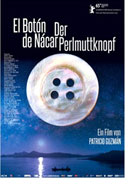

Opening 10 Dec 2015
Directed by:
Patricio Guzmán
Writing credits:
Patricio Guzmán
Director Guzmán opens this documentary with the ocean, skimming over the Chilean Western Patagonia Archipelago, which he says has an estimated 74,000 kilometers of coast, including islands, isles, inlets, peninsulas, rocks and fjord. He tells some of the history of the indigenous Fuegian people, who live in boats, traveling from island to inlet. One of the most famous was Orundellico, known as Jeremy Buton (or Jemmy Button) who in 1930 was taken to England by Captain FizRoy on the HMS Beagle. Button was paid for with a mother of pearl button, leading to his name change. He learned English and was considered “civilized,” but he returned to Chile where he went back to his native ways. Most of the Fuegian people did not survive, at one time being used as game for conquering explorers. Some of the stories are told with old photographs. Some scenes are staged, such as interviews with the last surviving descendants of the original settler or of the Archipelago, Gabriela Paterito, a Kaweskar, and Cristina Calderon, a Yagan.
It is the button, however, that provides a link to the second part of the film which investigates the treatment of political victims under Augusto Pinochet. Guzmán found a button wedged in the rails recovered from the oceans. These rails, as shown by demonstration in the film, were tied to people, (believed sometimes to be still alive) to weigh victims down after they were thrown from helicopters into the ocean. This is an engrossing film about man’s inhumanity to man. Guzmán says it best in the press paragraph for the film.” Some say that water has memory. This film shows that it also has a voice.” Guzmán gives that voice an audience. He received the Silver Bear for Best Script at the 2015 Berlinale. (Mary Wienke) (Mary Nyiri)